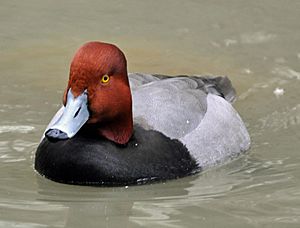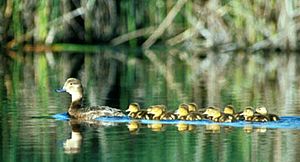Redhead (bird) facts for kids
Quick facts for kids Redhead |
|
|---|---|
 |
|
| Breeding male | |
 |
|
| Female with young | |
| Conservation status | |
| Scientific classification | |
| Genus: |
Aythya
|
| Species: |
americana
|
 |
|
The redhead (Aythya americana) is a medium-sized diving duck. Its scientific name comes from Greek and Latin words. Aithuia is an old Greek word for a seabird, and americana means "of America."
This duck is about 37 cm (15 in) long. Its wings can spread out to 84 cm (33 in). Redheads usually weigh between 2.0 and 2.5 pounds (907-1134 g). Males are a bit heavier, averaging 2.4 pounds (1089 g), while females average 2.1 pounds (953 g).
The redhead belongs to a group of ducks called Aythya. There are 11 other types of ducks in this group. The redhead is very closely related to the common pochard. Both of these ducks are also close relatives of the canvasback.
People call the redhead by other names too, like the red-headed duck. It's easy to spot this duck, especially the male. During the breeding season, males have a bright copper-colored head and a shiny blue bill.
Contents
About the Redhead Duck
What is a Redhead Duck?
The redhead is a type of pochard. Pochards are special diving ducks that are great at finding food underwater. Their legs are set further back on their bodies. This helps them swim and dive, but it makes walking on land a bit harder.
Redheads have larger webbing on their feet than other ducks. Their bills are also wider. These features help them find food underwater. Pochards also have a special lobed toe on the back of their feet. Unlike some other ducks, redheads do not have shiny, metallic-colored feathers on their wings.
How to Spot a Male Redhead
During the time they breed, adult male redheads have a striking look. Their head and neck are a bright copper color. They have a black chest. Their back and sides are grey, and their belly is white. The area near their tail is a light black.
Male redheads have pale blue bills. The tip of their bill is black, with a thin ring of color separating the blue and black parts. When it's not breeding season, the males lose their copper head color. Their heads turn brown instead.
How to Spot a Female Redhead
Adult female redheads look different from males. Their head and neck are usually yellow to brown. Their chest is brown, and their belly is white. The rest of their body is a mix of grey and brown.
Female redheads have slate-colored bills. The tip of their bill is dark, and a blue ring separates it from the rest of the bill. Unlike males, female redheads keep the same colors all year round.
Where Redheads Live
Redhead Duck Locations
Redheads live in many places across North America. During the breeding season, you can find them from northern Canada all the way down to the Caribbean. They especially like areas in British Columbia, Alberta, Saskatchewan, Manitoba, and the Dakotas. Some can also be found in Ontario, Quebec, and the southern United States.
When winter comes, these ducks fly south to warmer places. These winter homes include the southern United States, Mexico, Guatemala, Cuba, and the Bahamas. In both summer and winter, redheads prefer to live in wetlands.
Redhead Duck Habitats
Redheads like small wetlands that don't dry up easily. These wetlands should be in open areas, not forests. The water needs to be deep enough to have lots of tall plants growing in it. These plants are perfect for building nests.
In winter, redheads move to large bodies of water near the coast. They prefer places that are protected from big waves. You can also find them in reservoirs, lakes, wetlands that sometimes dry up, river deltas, coastal marshes, estuaries, and bays.
Redhead Duck Life Cycle
Redhead Duck Reproduction
Female redheads build their nests using strong plant materials. They often build them in thick plants like cattails or bulrushes. These nests are usually built over or very close to standing water.
Redheads are quite social ducks. They don't usually defend a specific area or home range during breeding season. Sometimes, younger female redheads will lay their eggs in the nests of other ducks. This is called "social parasitism." They might lay eggs in the nests of canvasbacks, ring-necked ducks, or scaups. This can make it harder for the other ducks' eggs to hatch.
Because of this, sometimes you can find hybrid ducks. These are mixes of redheads and other ducks like the ring-necked duck or canvasback. Interestingly, redhead and canvasback hybrids can sometimes have their own babies.
A redhead mother usually has 5 to 7 young ducks. She leaves her chicks when they are about 8 weeks old. At this age, they still can't fly. They need another 2 to 4 weeks before they are ready to take flight.
Redhead Duck Sounds
We don't know much about the sounds redheads make, except for their calls during breeding. Males make special calls when they are trying to attract a female. When a male stretches his neck fully, he makes a distinct "wheee-oww" sound. It can sound a bit like a cat. Males might also make a soft coughing sound, but this is less common. Females make a soft "errrr" sound when they are trying to get a male's attention.
What Redheads Eat
All pochard ducks, including redheads, eat both plants and small animals. What they eat changes depending on the season. During the breeding season, redheads eat as many animals as they can. This includes small snails, other mollusks, and insect larvae. They might also eat some grass and other plants that grow in the water.
However, when they fly south for the winter, redheads mostly eat plants. Their diet then includes things like pondweeds, wild rice, wild celery, wigeon grass, bulrushes, muskgrass, and shoal grass.
Redhead Duck Population
The number of redheads in North America is doing well. The goal for their population is 760,000 birds. However, their numbers have grown to over 1.4 million birds in recent decades!
Redheads make up about 2% of all ducks in North America. Only about 1% of ducks hunted are redheads. Their population might be stable because there are rules about how many can be hunted. Also, they use wetlands that don't often dry up, which helps them breed successfully. Groups are working to protect these wetlands for the future.
Images for kids
See also
 In Spanish: Porrón americano para niños
In Spanish: Porrón americano para niños







